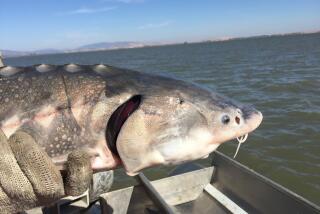ENVIRONMENT : The Rise and Fall of Alaska’s Wildlife
- Share via
A big-city advertising executive recently called the U.S. Fish and Wildlife Service’s office in Anchorage seeking information about the “endangered grizzly bear.” The ad man was designing a campaign for a soft drink company featuring such animals.
The trouble, however, is that the grizzly is not endangered in Alaska at present. Far from it.
The call illustrates the widespread misunderstanding many have about wildlife populations--good and bad--in the greatest remaining frontier for America’s wildest animals.
With the assistance of the Fish and Wildlife Service, the National Marine Fisheries Service, the National Marine Mammals Lab and the Alaska Department of Fish and Game, The Times offers this primer on the conditions of notable mammals and birds in Alaska.
LARGE LAND MAMMALS
* POLAR BEARS: 3,000 to 5,000. Considered a healthy population. Protected against all but subsistence hunting.
* GRIZZLY OR BROWN BEARS: 32,000 to 43,000. A stable and healthy population. “In most areas of this state there are as many bears as there ever were,” said David Kellyhouse of the state Fish and Game Department. Some of their habitat is now on the decline due to extensive logging in southeast Alaska forests.
* BLACK BEARS: 100,000 to 200,000 or more. Population expanding and causing friction with urban dwellers. Fifty black bears were trapped in downtown Juneau last year.
* WOLVES: 5,900 to 7,200. Believed to be stable and healthy population.
* CARIBOU: 835,000. This is a modern high, but population are known to fluctuate significantly in number.
* MOOSE: 144,000 to 166,000. Stable and healthy.
* DALL SHEEP: 60,000. Down from recent highs but believed stable.
* MOUNTAIN GOATS: 13,000 to 15,000. Stable
* BLACKTAILED DEER: 350,000 to 400,000. Stable so far, but losing habitat due to logging.
* MUSK OX: 2,100. After being hunted to extinction in Alaska, a reintroduced population is increasing in number.
SEA MAMMALS
* STELLER SEA LION: Approximately 50,000. Listed as threatened under the Endangered Species Act. Population declining precipitously--more than 80% in the last 40 years in its core breeding area.
* WALRUS: 201,000 in areas shared by the United States and Russia. Healthy but possibly declining. Protected from hunting except by natives.
* SEA OTTERS: 250,000. Healthy and increasing.
* KILLER WHALES: 500 or more. Little is known of population dynamics, except in Prince William Sound. There, one group of whales has shown decline, but others remain in stable numbers.
* BOWHEAD WHALE: 7,800. Listed as endangered. Believed to be increasing in number.
* RIGHT WHALE: Seldom seen. Listed as endangered. May be biologically extinct in the region.
* GRAY WHALE: 21,000 on the eastern side of he Pacific. Listed as endangered, but removal from list is pending.
* HUMPBACK WHALE: 1,200 to 1,500. Endangered.
* NORTHERN FUR SEAL: 800,000 to 900,000. Listed as a depleted population from former high of 2 million.
* HARBOR SEAL: 100,000. Appear to be in rapid decline along with the steller sea lion.
* BELUGA WHALE: 15,500 to 19,000. Apparently stable.
* RINGED SEALS: 1 million. Stable.
* ICE SEALS (spotted, bearded, ribbon): Population unknown, but probably 100,000-plus for each species. Believed to be stable.
BIRDS
* BALD EAGLES: 35,000-plus. Healthy population. (This compares to 5,000 or fewer in all the other states combined).
* DUCKS (30 species): 4.4 million. This represents an 11% increase since 1970.
* SPECTACLED EIDER: 5,400. An exception to the above, this duck shows a shocking decrease from its traditional 100,000 to 140,000 pairs. Currently proposed for protection under the Endangered Species Act. (Coincidently, this duck was chosen in 1992 to illustrate the federal duck stamp for hunters).
* STELLERS EIDER: 70,000 to 100,000. Also in decline and proposed for protection.
* GEESE (Cackling Canada, white-fronted, emperor, black brant): 500,000-plus. These migratory birds are recovering slowly after population crashes in the early 1980s that affected most species.
* ALEUTIAN CANADA GEESE: 7,000. Once endangered with only 600 to 800 remaining, this bird is on the rebound and was reclassified as threatened last year.
* SEA BIRDS (60 species of albatross, gulls, puffins, kittiwakes, shearwaters, fulmars, etc.): Migratory population: 100 million. Breeding population: 50 million. Of sea birds that breed in the United States, 96% are in Alaska. Most populations are considered healthy.
* SHORT-TAILED ALBATROSS: 300 to 400 worldwide. Long listed as endangered. Thought to be increasing.
* PASSERINE BIRDS (Crows, ravens, owls, woodpeckers, etc.): No census taken. Alaska officials say they believe that if any species of these birds is in trouble, it is the result of habitat degradation elsewhere along their migration routes.
* PEREGRINE FALCON: 616. Endangered. Increasing 10% per year in last five years.
* ESKIMO CURLEW: Rare reports of sightings. May be extinct.
More to Read
Sign up for Essential California
The most important California stories and recommendations in your inbox every morning.
You may occasionally receive promotional content from the Los Angeles Times.










